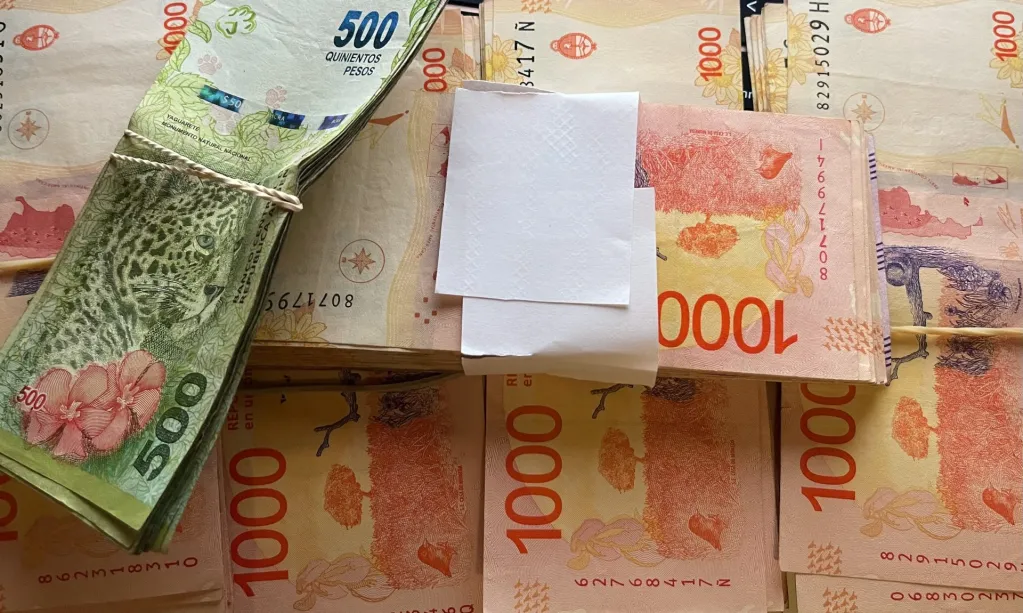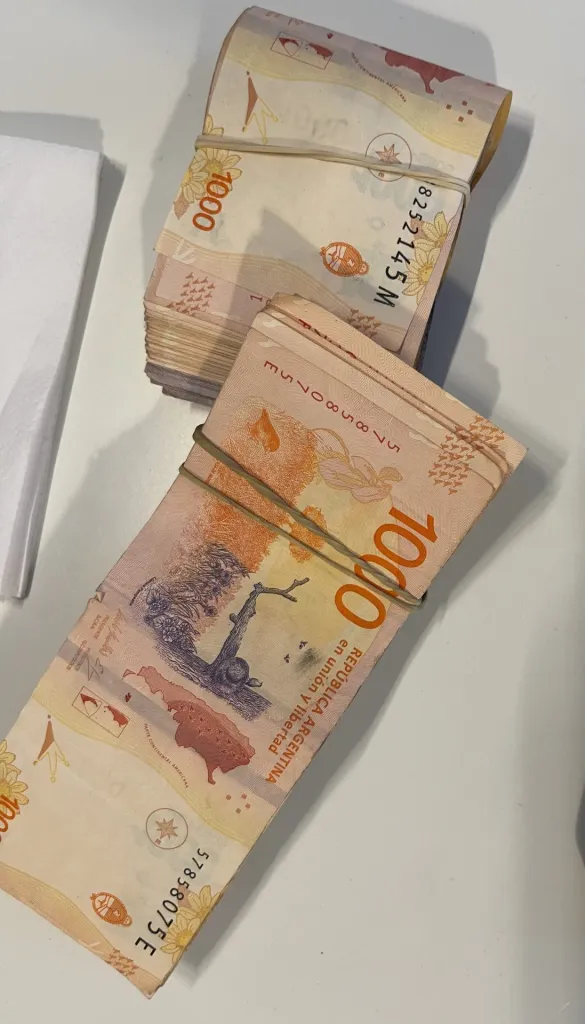Dólar Blue? Don’t you mean black? No, I don’t. And here’s why you need to know about the ‘blue dollar’ before visiting Argentina.
Note: While the ‘honeymoon period’ with the new President is ongoing, you should use the blue rate cash from Western Union as an alternative to ATM withdraws, which have large fees. And you should use a Wise digital debit card for paying everywhere else. Rates are currently inverted and the ‘Dolar MEP’ (tourist dollar) is currently sitting above the ‘Dolar Blue’ (unofficial dollar). See the live rates rates below.
What you need to know about the dolar blue in Buenos Aires, Argentina

What Is The Dólar Blue ?
The ‘black market’ exchange rate for the United States Dollar (USD) to Argentine Peso (ARS) is called the ‘dólar blue‘. The dólar blue is the real exchange rate operating in Argentina and its based on principles of supply and demand.
The dólar blue is not a traditional black market. It doesn’t operate in shadowy corners of the city. It isn’t controlled by criminals.
In fact, you can view the current dólar blue rate online on many websites. And every legally registered currency exchange shop in the country will give you the dólar blue rate.
In Argentina, if a currency exchange shop (casa de cambio or bureau de change) doesn’t conduct exchanges at the current blue rate, they quickly go out of business. Nobody willingly changes their money at the official exchange rate when they can find another shop within a block or two that will give them more than twice as much.
The dólar blue rate is so common in Argentina that even Western Union makes use of the dólar blue. Money transfers into Argentina via services like Western Union convert foreign currency into Argentine pesos at the current blue rate.
In contrast to the dólar blue, the official exchange rate set by the central bank of Argentina is only applied to electronic transactions. And transactions that go through Argentina’s banks.
Avoiding the Argentine banking system allows locals and foreigners to avoid the official currency exchange rate set by the central bank of Argentina. But let’s look at why there is a second exchange rate and why you’d want to avoid Argentina’s banking system.
Why Is There A Second Exchange Rate In Argentina? The Dólar Blue
With the dólar blue so common throughout the country, you’re probably wondering why there is an official exchange rate. Or why Argentina has two different exchange rates and why the dólar blue exists. Well, Argentina actually has more than 30 different exchange rates and it’s because Argentina is a predominantly cash economy.
Argentina has experienced more than its fair share of financial crises. Enduring an average of one financial crises in every five to ten year period for the better part of the last two centuries.
Though the current problems are mainly due to Argentina being stuck in a downward debt spiral. As successive government’s have been running huge fiscal deficits for more than four decades.
The Government of Argentina spends much more than it receives. Argentina runs on borrowed money. It has huge social welfare and subsidy programs. Argentina subsidises the cost of utilities, transportation and provides for the health care and pensions of all its citizens.
In order to meet its obligations to its citizens, Argentina takes out massive international loans from the IMF and World Bank. And the Argentine central bank continuously prints money to pay for the government’s expenses.
The loans taken out by the Government of Argentina coupled with the huge money printing programs carried out by the central bank of Argentina make the Argentine peso worth less against the USD by the minute. It creates huge inflation.
This year alone, inflation has topped 100% and it’s anticipated to go above 140%. That means Argentina’s peso relative to the USD will lose more than 140% of its value. The peso will have 140% less purchasing power.
As you can imagine, nobody wants their savings to lose 140% year on year. So Argentina’s citizens don’t want to keep their money in pesos. They want to change their money into a currency that isn’t being eaten away by triple digit inflation.
Argentina’s citizens want to keep their life savings in a currency that isn’t losing value by the minute. And this creates the demand for USD. Which is viewed as a global safe haven currency. It’s also the currency in which property transactions are conducted in Argentina.
As an example, if you were saving for a house and your savings lost 140% of their value year on year, you’d never be able to own a home. And this huge inflationary dilemma is why Argentines who can afford to save don’t want to keep their money in pesos.
Yet, as Argentina’s own citizens flee the peso, this also adds to the problem of inflation in Argentina. Because a currency is only ever as strong as the demand for it. And as the demand for USD grows in comparison to Argentina’s peso, this contributes to the downward spiral of Argentina’s economy.

Why Does Everyone Use Cash In Argentina?
Due to the huge local demand for USD in Argentina the government attempts to control and limit the supply of foreign currencies. Argentines don’t often keep their life savings in Argentine banks. Instead, they keep their savings in cash or property.
On more than a few occasions in as many decades, the Argentine government has pilfered the life savings of its citizens to pay government debts. And it has seized retirement savings and has converted dollar denominated bank accounts into pesos at official rates.
To go back to the property example, imagine you’d saved the cost of a house in dollars in your Argentine bank account. Then picture how you’d feel if the government suddenly decided to take your dollars right out of your account and give you pesos at official rates. Wiping out 50% or more of your savings.
Well, for a lot of Argentina’s citizens their bank accounts and retirement funds have been raided by the government more than once. And they won’t willingly choose to keep their savings in a bank.
Because Argentines don’t use Argentina’s banks, this further restricts reserves of foreign currency and increases the local demand for USD. And Argentina has an insatiable appetite for USD.
Argentina is thought to have one of the largest hoards of $100 USD notes. With Argentina thought to be the final destination for more than one in every fifteen USD in circulation. None of which is available to the government through the banking system.
Most of the USD owned by Argentina’s citizens doesn’t circulate in Argentina. It’s bought by Argentinians and stuffed in walls, under mattresses, below floor boards and hoarded in offshore accounts.
Argentina’s citizens can’t keep USD in their bank accounts and retirement funds without the risk of the government looting their savings. So they buy up all the available USD cash and hide it away for a rainy day. Making it difficult for the government to access foreign reserves.
In response to what is the end product of the distrust their own past policies have created, the Argentine government places limits on the amount of USD a citizen of Argentina can buy each month. And they add controls on the exchange rate and levy huge taxes on cross border transactions.
Avoid Using Bank Cards And ATMs In Argentina!
If you use an ATM in Argentina you can expect to see transaction charges that can exceed 50% of the transacted value. And the official exchange rate will be the rate at which your money is converted.
If you’re a tourist visiting Argentina and you use your foreign Visa or Mastercard then theoretically the transactions should be processed at the ‘tourist dollar’ MEP rate (aka ‘Mercado Electrónico de Pagos’ or ‘Dólar Bolsa’). Which is lower than the ‘dólar blue’ rate but higher than the official rate. Yet in reality, Visa and Mastercard never pass on the MEP rate in full.
If you change cash at a bank or in anyway interact with a bank in Argentina you can expect to have your currency converted at the official exchange rate. And have large fees added to your transactions.
To give you a better idea of what you lose by using a bank or ATM to convert your currency in Argentina, here’s a comparison of the rates at the time of writing this article.
| Official Rate | Tourist Dollar – MEP Rate | Dólar Blue | Western Union | |
| Rate (ARS:USD) | 349:1 | 656:1* | 710:1 | 725:1 |
| $1000 USD in Pesos | A$349,000 | A$656,000* | A$710,000 | A$725,000 |
| Method | Electronic transfer, use of bank cards or cash exchanged at a bank | Use of a foreign Visa or Mastercard to pay for goods and services | Cash | Mobile application or internet |
Live exchange rates for Argentina can be found at https://dolarhoy.com
As you can see above, using Western Union to get cash results in more than twice the amount of Argentine pesos then if you were to use a bank card (credit card or debit card) or change USD cash at a bank. And Western Union’s rate today is currently above the blue market rate.
If you were to change USD cash into Argentine pesos with an exchange shop (not a bank) and get the full blue market rate you’d have more than double the amount of money to spend in pesos. However, using an exchange shop (casa de cambio or bureau de change) in Argentina will require you to have pristine $100 USD bills of the latest series (large face – printed after 1996).
As noted above, Argentina’s citizens hoard USD $100 notes. And they will only want the latest series (not older notes) that have no markings or signs of wear and tear.
If the notes you bring to Argentina look worn or have a marking that would make them distinguishable from another, you will get a lesser rate. And some currency exchanges will refuse to exchange any note that is not in as new condition.
Scenario – Using A Foreign Credit Card In Argentina With Uber
Any purchase or payment for goods and services you make in Argentina as a foreigner using your foreign card will be be applied at the MEP exchange rate set by the Government. Minus the large chunk of change that everyone involved in the transaction (including Visa and Mastercard) scalp off the top.
As an example, if you take an Uber from the Airport to Palermo it will set you back around 5000 pesos as a base price. If you use your card through Uber it will cost about $15USD. But if you pay the Uber driver cash in peso that you’ve exchanged at the dólar blue rate it costs around $7USD. Saving you more than 50%.
The same sorts of savings are applicable for renting accommodation on platforms like Airbnb or buying goods and services. The shopkeepers, waitresses and Uber drivers don’t get the difference. In the example above the Uber driver doesn’t get the extra $8 USD.
The difference just disappears in the transaction thanks to the exchange rate set by the Government. And the various exchange fees and credit card fees set by Visa, Mastercard, banks and vendors involved in processing the transaction.
To avoid losing money on Argentina’s exchange rates any expat, digital nomad or savvy foreign tourist will pay cash in peso everywhere. As the official exchange rate is likely one of the biggest scams you’ll encounter in Argentina.

Bringing Cash To Argentina Versus Western Union
In order to avoid the official exchange rate, visitors to Argentina will either bring USD into Argentina or access cash through an international transfer service like Western Union. The method used will typically depend on a tourists country of origin.
If a traveller is American or coming to Argentina from the USA they typically bring some cash in USD with them. As they don’t have to pay an exchange office or bank to first transfer into USD from some other currency.
I’m Australian. And transferring money into USD cash so I can then transfer it into Argentina’s peso is a huge pain in the proverbial. And not worth the effort as each transfer (from AUD to USD and then USD to ARS) comes with a transaction cost. Meaning it’s not worth the extra effort for me to bring USD cash into Argentina.
Visitors to Argentina who’s home currency isn’t USD should investigate Western Union. Western Union typically pays out pesos at around the current dólar blue rate. And Western Union often works out cheaper than first transferring $AUD, £Pounds or €uro into $USD only to then try and convert it to Peso by cutting out one of the middlemen.
Western Union transfers from the Wester Union mobile application are instant. Allowing anyone to send money to themselves and use Western Union like an ATM. Which is what I do.
At times, like today, I can get higher than the current dólar blue rate by using Western Union. I just need to periodically keep an eye on where the rate is hovering. But the Western Union rate most often tracks along with the dólar blue and is most commonly at parity with the blue rate.
Limitations When Changing USD Cash To Argentina Peso
Virtually any exchange shop will change USD to ARS at the blue rate. Banks change money at the government rate. So avoid changing money at banks.
Just walk into a reputable private exchange shop (casa de cambio or bureau de change) and ask for the ‘dólar blue’ rate. If you’re foreign and they don’t think you know about the blue rate they may try and make some extra money off you. So if they don’t immediately offer you the blue rate make sure you specifically ask for it.
In the unlikely event that you do find a currency exchange in Argentina that won’t give you the dólar blue rate, don’t worry. As there is more than likely another one that will give you the dólar blue rate on the same block. As these exchange shops are literally everywhere.
When changing cash in Argentina always do it at a reputable shop. As in a physical location with brand and signage. Don’t attempt to change money with some guy standing around on the street yelling ‘cambio, cambio.’
There’s a lot of independent money changers around places like Florida Street in Centro and other shopping areas throughout Buenos Aires. And they will either try to scam you on the rate, give you counterfeit cash or just rob you.
Every YouTuber passing through town makes a video about Florid Street in Buenos Aires. But you should avoid Florida Street. Unless you’re a local or have spent considerable time in BA and know what to expect, avoid Florida Street.
Dirty, Worn, Marked Or Ripped USD Bank Notes In Argentina
When using a currency exchange shop and changing money, the cashier might point out to you that a note you’ve presented has a mark on it. They’ll then offer to buy that note at a discount. And you should decline.
Trying to take notes for a discount because of wear and tear is just the cashiers way of trying to make a higher profit margin on your sale of USD.
These exchange shops will still sell the note at full price to the next customer. And the pesos they’ll give you in the exchange will all be in a used condition.
Don’t give the currency exchange shops marked notes for a discount. Instead use those notes to pay for your accommodation, exchange them with an Argentine friend or save them and exchange marked bank notes at a bank in Uruguay.
And don’t bring other currencies to Argentina. As the population only wants USD. So you’ll definitely get a terrible exchange rate trying to exchange currencies other than USD in Argentina.

Exchange Rates Argentina FAQ
What is the best currency to take to Argentina?
If you’re going to bring hard currency cash into Argentina then the USD is the best to bring. Argentina has an insatiable appetite for high quality $100 USD bills. And these bills will net you the best exchange rates.
Currencies other than USD are less popular. And the exchange rates for other currencies will not be as good as that provided for USD cash.
Should I bring dollars to Argentina?
If your home currency is USD or you have access to USD cash at home without paying a transaction fee, then it can be worth bringing some USD cash. However, the notes will need to be $100 bills in perfect condition to get the full dólar blue rate. Dirty, worn, marked or older notes will not get you the full dólar blue rate.
Often it is much easier to simply send yourself money via a transfer service like Western Union. And Western Union often nets its users a better exchange rate.
Should I use a credit card in Argentina?
You should not use foreign cards in Argentina. Your cards will work but they will attract large fees and charges. Foreign cards will also result in the official MEP exchange rate being applied. Minus exchange fees and charges. Meaning that everything you pay for in Argentina will cost much more with your foreign card compared to if you paid cash.
Didn’t the Government of Argentina change the laws to allow higher rates for tourists?
In November 2022 the Government of Argentina made it legal for foreign card transactions made in Argentina to be processes at the ‘tourist dollar’ MEP Rate (aka ‘Mercado Electrónico de Pagos’ or ‘Dólar Bolsa’). Visa and Mastercard rushed to sign up for the change.
Yet Visa and Mastercard do not pass on the full MEP rate. You will get an exchange rate that is halfway between the official rate and the MEP rate before vendor surcharges and other bank related fees and charges.
As an example, today the offical rate is 349:1, the MEP rate is 656:1 and the dólar blue is 710:1. Yet my Visa card is processing transactions at 497:1. And I am significantly better off using cash acquired from WU at 725:1 as opposed to using my Visa card with an exchange rate of 497:1.
How much cash can you bring into Argentina?
You can carry $10,000 USD into Argentina before needing to declare your funds. Though you really don’t need to bring cash to Argentina. And should instead use Western Union.
Can I send money to myself in Argentina through Western Union?
You can send money to yourself in Argentina via Western Union. This is the easiest way to get funds into Argentina at the blue rate. Send yourself money via their app and pick it up from a Western Union branch.
In Argentina you will need to present your passport when collecting cash at a Western Union outlet. So don’t forget to take your passport with you when collecting your cash in Argentina. Without your passport you will be turned away.
Does Western Union give the Dólar Blue Rate in Argentina?
Western Union provides a rate comparable to the dólar blue rate. Sometimes it is a little less than the current blue rate and other times it is slightly above the blue rate. Yet it’s most often at parity with the dólar blue rate.
Download the Western Union app for your country and check the rate for your home currency. And remember, if using cash instead of Western Union, you will need to pay a currency conversion fee on each exchange (into USD and then USD into pesos) of 3-5%.
Where Can I Get More Information About Buenos Aires?
If you’re planning to visit Buenos Aires on your next vacation, or you’re simply interested in Argentina in general, you should read my Buenos Aires City Guide.
My Complete Buenos Aires City Guide is updated regularly. And it seeks to answer all of your questions regarding Buenos Aires and Argentina in one place. Read my Complete Buenos Aires City Guide.




